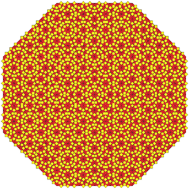Mathematical diffraction of aperiodic structures†
Abstract
Kinematic diffraction is well suited for a mathematical approach via measures, which has substantially been developed since the discovery of quasicrystals. The need for further insight emerged from the question of which distributions of matter, beyond perfect crystals, lead to pure point diffraction, hence to sharp Bragg peaks only. More recently, it has become apparent that one also has to study continuous diffraction in more detail, with a careful analysis of the different types of diffuse scattering involved. In this review, we summarise some key results, with particular emphasis on non-periodic structures. We choose an exposition on the basis of characteristic examples, while we refer to the existing literature for proofs and further details.

- This article is part of the themed collection: Quasicrystals

 Please wait while we load your content...
Please wait while we load your content...